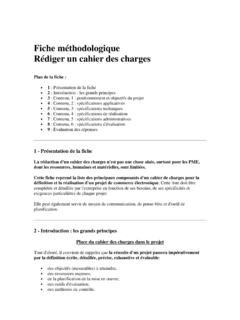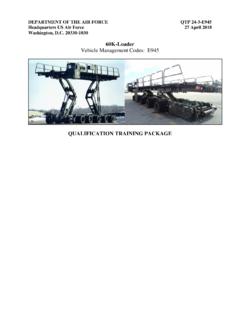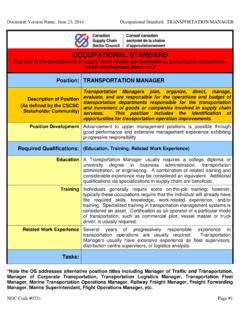Transcription of A Guide to - LOMAG-MAN .Org
1 A Guide to Forklift Safety July 2005 Forklift Safety This publication is based on the WorkSafe Victoria publication Forklift Safety Reducing the Risk and its accompanying CD Forklift Safety Don t Learn it by Accident . Disclaimer This document provides general information about the rights and obligations of employees and employers under ACT occupational health and safety laws. It is intended to provide general information about the law and is not intended to represent a comprehensive statement of the law as it applies to particular problems or to individuals, or substitute for legal advice. You should seek independent legal advice if you need assistance on the application of the law to your situation. FORKLIFT SAFETY 3 Contents Introduction .. 4 Overview of Forklift Injuries and Fatalities .. 4 Pedestrians and Forklifts Don t 4 Forklift traffic management .
2 5 traffic management 5 Basic traffic management : 6 truck Loading And Unloading: 7 Forklift Stability .. 8 Key Risks to Forklift Stability .. 8 Managing Rollover Risk for Forklift Operators .. 8 Managing Rollover Risks, for 9 Design Features and Intelligent Systems .. 9 Speed and Braking 10 Minimum Actual Emergency Stopping Distance .. 10 Loads and Load Handling .. 12 Forkarm Attachments .. 12 Raising People .. 14 Maintenance Work Platforms .. 14 Order Picking Lift Trucks .. 14 Poorly Ventilated Workplaces .. 15 Slips, Trips and Falls .. 16 Sprains and Strains .. 17 Maintenance .. 18 Maintenance Program .. 18 Pre-Operational 19 Legal Requirements .. 20 Employers Duties .. 20 Consultation .. 20 Employees Duties .. 20 Policies and 21 Selecting A Suitable Forklift .. 21 Incident Reporting .. 21 Training and Licensing .. 21 traffic management 22 traffic management Plan Comparative Chart.
3 23 FORKLIFT SAFETY 4 Introduction The forklift truck can be one of the most dangerous pieces of equipment in the workplace. A medium sized forklift weighs about the same as your average dump truck and can cause just as much damage and injury when travelling around your workplace. This Guide will help you to identify some of the potential risks, and provides solutions and tips to help reduce injuries and fatalities resulting from unsafe forklift operation. Most importantly, the Guide provides employers and business owners with detailed information about developing a forklift traffic management Plan, which is the key to eliminating or minimising the serious risks to health and business performance associated with poor forklift practices. Overview of Forklift Injuries and Fatalities Collisions with pedestrians and loads falling onto pedestrians (29% of injuries, 56% of fatalities) Rollovers and unexpected movement of forklifts crushing operators (29% of fatalities) Persons falling from makeshift platforms elevated on forklift fork arms (12% of fatalities) Slips, trips and falls getting on and off forklifts (operators) (27% of injuries) Body stressing (sprains and strains) while driving forklifts (operators) (19% of injuries) Pedestrians and Forklifts Don t Mix The key lesson to be learnt is that pedestrians must be kept at a safe distance from working forklifts.
4 Even at low speeds, an unexpected movement of the forklift can crush a bystander against a fixed structure or another vehicle. Without significant change to the way forklifts are used, there will be an ongoing and unacceptably high risk of serious injuries and death. For people suffering severe injury, or the surviving families of people killed, the effects are devastating. For employers and business owners that failed their legal duty to provide a safe workplace, the legal and financial costs can be overwhelming. Sadly, many employers and employees only become aware of dangerous practices as the result of a serious accident at their workplace. Supervisors and managers must be aware of how a forklift is operated, and the hazards involved. Please take the time to read and understand this information, and then take a look at your forklift operations. And do it today.
5 FORKLIFT SAFETY 5 Forklift traffic management When pedestrians work or move in close proximity to operating forklifts, there is a risk of serious injury occurring. Ensuring the safety of pedestrians is a critical aspect of workplace traffic management . Protecting pedestrians at the workplace requires decisive action to prevent, not just discourage, pedestrians and forklifts from coming into close proximity. Don t learn forklift safety by accident! Pedestrian exclusion zones and forklift exclusion zones must be based on forklift movements, braking distance, stability of the forklift and the loads being handled. Forklift traffic management is not a matter of common sense . Forklift traffic management is about minimising risk through the application of systematic controls supported by clearly defined and enforced rules of the road . Health and Safety Representatives, forklift operators, other workers and employees should all play a part, and will result in many ideas and observations related to forklift operations, safety and possible solutions.
6 When identifying risk control measures consider the source of the risk and develop practical, workable controls. Once risk controls are in place they must be regularly reviewed to gauge effectiveness. traffic management Plans A traffic management plan is essential to address many of the risks associated with the use of forklifts in the workplace. Safety of pedestrians is the most important aspect of a workplace traffic management plan. When preparing traffic management Plans: Carefully study the way forklifts and pedestrians move, or need to move, around your workplace and identify all places where there is potential for collisions between forklifts and pedestrians, or forklifts and other vehicles, columns, racking etc Consider the way the forklift mast, load or stacked goods obstruct the operator s view Consider the braking distance of laden forklifts, the distance loads could fall (including rolling/ splashing) and the factors affecting forklift stability.
7 Consider the most efficient route for traffic flows and reduced frequency of interaction with hazards. traffic management Plan Controls may include: substituting a forklift with other suitable load shifting equipment and, where reasonably practicable, eliminating the risk altogether. Change the workplace layout to minimise cross flow of traffic , intersections and blind spots, and to separate pedestrians from forklift traffic and operations Clearly define forklift operating areas as pedestrian (including truck driver) exclusion zones, and pedestrian walkways/work areas as forklift exclusion zones Provide physical barriers around pedestrian walkways and work areas to define pedestrian safety zones and to prevent pedestrian access to forklift operating areas other than at defined pedestrian crossings. Don t rely only on painted lines and high-visibility vests to keep pedestrians safe.
8 Base forklift speed limits and the boundaries of pedestrian and forklift exclusion zones on the braking distance of laden forklifts, the distance loads could fall (including rolling/splashing) and the factors affecting forklift stability Conduct specific workplace proficiency training for forklift operators and include procedures that require forklifts to stop work if pedestrians enter a pedestrian exclusion zone FORKLIFT SAFETY 6 Provide training and procedures on forklift traffic safety to all employees and any visitors at the workplace, and supervise work to ensure that procedures are followed Maintain good area lighting, ensure that high-visibility clothing is worn by pedestrians, and ensure that forklifts, obstructions, low beams/doorways edges, drains etc are marked with high-visibility colours The section traffic management Plan Comparative Chart at the end of this Guide gives details of many specific risks, issues and controls that should be considered when preparing plans.
9 Basic traffic management : Example As outlined the key to effective forklift traffic management is to separate pedestrians and operating forklifts. The following diagram illustrates how the principles outlined in the comparative charts can be adopted to implement an effective traffic management system for the workplace. Objectives of this diagram are to: Convey clear separation principle Convey stopping distances and relationship to speed and space Pedestrian/forklift intersections are minimised Convey higher level of controls. Designated pedestrian walkway, clearly delineated, with physical barriers to ensure isolation of pedestrians. A pedestrian exclusion zone has been established for a distance equal to the height of the load from the ground plus an additional allowance for the nature of the load. The driver must be in full view to a forklift operator.
10 All loading or unloading must stop if the driver cannot be seen or needs to enter exclusion zone to inspect load. Alternatively, if it is safe to do so, the system of work can provide for the driver to stay in the cabin during loading and unloading. Distance walkway is away from building is determined by speed of operating forklifts and subsequent safe stopping distance. Beam from pedestrian sensing device Warning light activated by pedestrian sensors Staggered barriers, to control pedestrian approach Bollards/Witches hats/paint marking the perimeter of the pedestrian exclusion zone. FORKLIFT SAFETY 7 truck Loading And Unloading: Example As outlined the key to effective forklift traffic management is to separate pedestrians and operating forklifts. The following is an example of how the principles outlined in the comparative charts can be adopted to implement an effective traffic management system for the loading and un/loading of vehicles.










